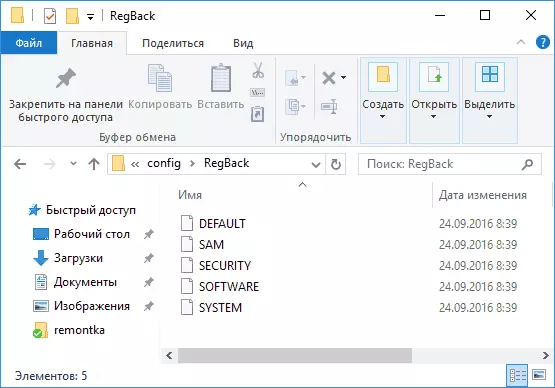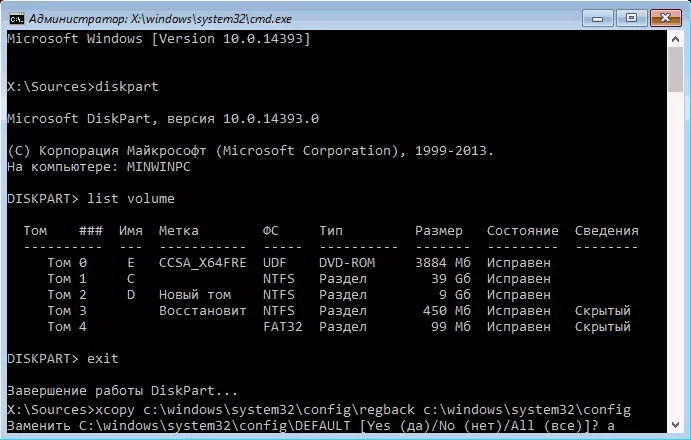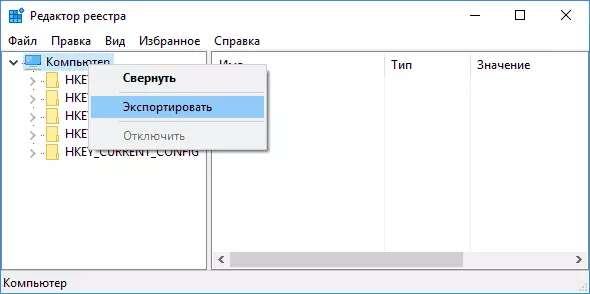
In this instruction details how to restore the registry from a backup in Windows 10, as well as other options for solving problems with registry files when they occur if the usual way does not work. And at the same time, information on how to create your own copy of the registry without third-party programs.
How to restore the Windows 10 registry from the backup
The backup copy of the Windows 10 registry is automatically saved by the system in the folder C: \ Windows \ System32 \ Config \ RegBack \
The registry files themselves are in C: \ Windows \ System32 \ Config \ (Default, SAM, Software, Security and System files). IMPORTANT: Do not use the method in versions of 1803, 1903 and newer, if you did not turn on saving a copy of the registry - Unfortunately, starting with Windows 10 version 1803, the default registry files are not automatically saved in the specified folder (but there may be empty files, which are not needed to replace the registry). But you can enable them to save them to the future (see how to enable the backup of the registry in the REGBACK folder).
Accordingly, to restore the registry, it is enough to copy files from the RegBack folder (there they are usually updated after updating the system affecting the registry) into the System32 \ Config folder.

You can make it easy tools of the system, provided that it starts, but more often it is not so, and you have to use other paths: usually, to copy files using the command line in the Windows 10 restore environment or booting from the distribution system with the system.
Next will be assumed that Windows 10 is not loaded and we perform steps to restore the registry that will look as follows.
- If you can hit the lock screen, then on it, click on the power button shown on the right below, and then holding the SHIFT, click "Reboot". The recovery environment will be loaded, select "Find and Troubleshooting" - "Advanced Settings" - "Command Line".
- If the lock screen is not available or you do not know the account password (which will have to enter in the first version), then boot from the Windows 10 boot flash drive (or disk) and on the first setting screen, press Shift + F10 (or Shift + Fn + F10 (or SHIFT + FN + F10 Laptops), command line will open.
- In the recovery environment (and command prompt when installing Windows 10), the letter of the system disk may differ from C. To find out which drive letter is assigned to the system partition, enter the DiskPart command in order, then List Volume, and Exit (in the results of the second command, mark For myself, what letter has a system partition). Next, to restore the registry, use the following command
- XCopy C: \ Windows \ System32 \ Config \ RegBack C: \ Windows \ System32 \ Config (and confirm the replacement of files by entering Latin a).

Upon completion of the execution of the command, all registry files will be replaced with their backups: You can close the command line and restart the computer to check whether Windows 10 has been restored.
Additional ways to restore the registry
If the described method does not work, and some third-party software to create backups was not used, then only possible solutions remain:
- Using Windows 10 recovery points (they contain a backup of the registry, but by default they have many disabled).
- Reset Windows 10 to the initial state (including data saving).
Among other things, on the future you can create your own backup registry. To do this, it is enough to perform the following simple steps (the following method is not the best and there are optional, see how to create a backup of the Windows registry):
- Run the registry editor (press Win + R, enter Regedit).
- In the registry editor, in the left pane, select "Computer", click on it with right mouse button and select the "Export" menu item.

- Specify the location of the file.
Saved file with .reg extension and will be your backup registry. To make data from it to the registry (more precisely, combine with current content), it is enough just to click on it twice (unfortunately, most likely, part of the data will not be able to be made). However, more reasonable and effective way, probably, is to enable the creation of Windows 10 recovery points, which will contain, including the working registry key.
